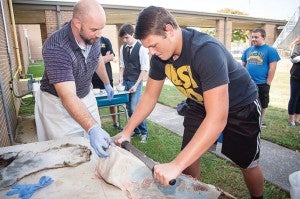EHS class studies Appalachian history, culture with hands-on lessons
Published 9:06 am Thursday, October 2, 2014
Growing vegetables, grinding corn, making corn husk dolls, weaving baskets and fleshing a deer hide.
Not your typical classwork.
But then, this isn’t your typical class.
Elizabethton High School students are learning those traditional Appalachian skills and others through special hands-on lessons in their Appalachian History and Skills special topics class.
Students spent the afternoon Wednesday fleshing a deer hide, removing flesh and fat from an animal skin so it can be tanned into leather.
The students also worked to grind corn kernels – which they had grown outside the school – into cornmeal.
Under history teacher Alex Campbell’s supervision, students worked in turns to flesh a deer hide. Campbell said he received the deer skin from the Unaka High School meat processing program.
“We are going to be making our own leather,” explained student Emily Babb. “It was fun. I liked it. I don’t get to hunt so I enjoyed being able to do this.”
Student Zeb Eggers said there is a balance to fleshing a hide so the skin is not damaged in the process.
“You don’t want to be too rough, or you will pull holes in the skin, but you have to be tough enough that it gets all of it off,” Eggers said. “It is a good skill to learn.”
Campbell said the goal of these exercises was to help teach students skills that were once common knowledge for past generations.
“Everyone’s grandparents had these skills and somewhere over the years they got lost,” Campbell said. “They went to school until about second grade and were called ‘uneducated,’ but now we have multiple degrees and can’t do the things they did every day.”
Lessons for the class started at the end of the last school year when Campbell’s class planted corn in the school’s mini-garden. They have now harvested the corn and are grinding the dried kernels into cornmeal. Later, the students will use the cornmeal to make cornbread.
“For about five hours of work, we have a half-cup of cornmeal,” Campbell said.
The students used the cornhusks from the corn to make cornhusk dolls. Campbell said these dolls are frequently sold at festivals for $15 to $20 each.
“They all did really well on that project,” he added.
Students also worked on weaving baskets from cordage or willow branches and bookmarks, straps and belts from wool.
Fleshing the hide was not the end of the line for the deer skin used for Wednesday’s project. Campbell said the ultimate goal is to turn the hide into a leather product, which means the students will be completing the entire tanning process.





